Kansai Area
| Nara | Himeji | Osaka |
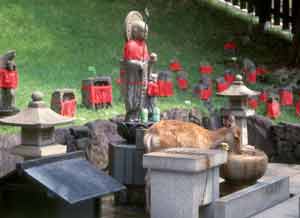
Although there is much to see in Kyoto, Japan's excellent rail system makes it easy to see other areas in the Kansai area. In fact with a Japanese rail pass Tokyo itself is only about 2.5 hours away on the shinkansen or bullet train.
Nara
Nara was Japan's first permanent capital. Although it was only the capital for 75 years from 710 to 785 before the capital moved to Kyoto these were the formative years which created much of the Japanese culture. With eight World Heritage Culture sites, it is second only to Kyoto as a repository of Japan's cultural legacy. Also like Kyoto it was one of the few cities not bombed during WWII.
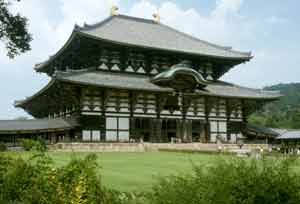
Nara is only a small city of about 350,000 people and most of its important sites can easily be reached on foot from the train station. Nara is only about 35 to 45 minute train ride from Kyoto depending on which train you catch. The people at the tourist office at the train station were very friendly, they even gave us posters. Pick up a walking map of the city.
Many of the sites in Nara are located in a large parkland called Nara-kōen located at the foot of Wakakusa-yama. The park is also home to about 1200 deer which were considered to be messengers of the gods and today have the status of national treasures. Many stores in the area sell biscuits to feed the deer.
Tōdai-ji with the huge Daibutsu-den hall, the largest wooden building in the world, and the bronze Buddha statue inside are the star attraction in Nara. The place will probably be packed with groups of school children been herded around by microphone wielding guides. On your way to the temple you will pass through the Nandai-mon gate which contains two carvings of Niō warriors, from the 13th century they are probably the largest wooden statues in the world.
The present Daibutsu-den hall, Hall of the Great Buddha, was rebuild in 1709, at only two-thirds the size of the original. The Buddha was originally cast in 746 and stands at 16 metres and consists of 437 tonnes of bronze and 130 kg of gold.
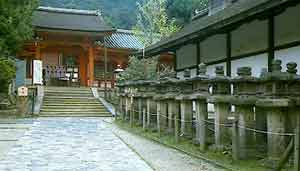
There are several other structures within the Tōdai-ji and also nearby is the Kasuga-taisha shrine. This shrine was founded in the 8th century by the Fujiwara family and was rebuilt every 20 years according to Shinto tradition. The approaches to the shrine are lines with hundreds of lanterns with many more hundreds inside the shrine. These lanterns are lit twice a year as part of lantern festivals. Bring food for the deer.
Before you arrive at Nara-koen park from the train station you will pass several notable sites. Kofuku-ji was transferred from Kyoto in 710. Although the original temple had 175 buildings, years of fires and civil wars as left only a dozen buildings which include two pagodas, the tallest one is only a few centimetres shorter than the one in Kyoto. The National Treasure Hall contains a variety of status salvaged from the previous buildings.
Nara also contains one the three National Museums in the country. There are archaeological finds and displays of sculptures, paintings and calligraphy.
If you have time you can visit the neighbourhood of Naramachi which contains many traditional houses and a short bus ride way there are several world heritage temples. Are they worth the trip? Don't know since I never had the time but some of them are the oldest in the country which were founded in 607. Let me know if they are worth the trip.
Himeji
Himeji is a castle town. Almost completely bombed flat during WWII it's a typical modern unattractive small Japanese city, except for the castle. There are only a few original (non-concrete) castles left in Japan and this is probably the most famous, you've probably seen posters or calendar pictures of it. 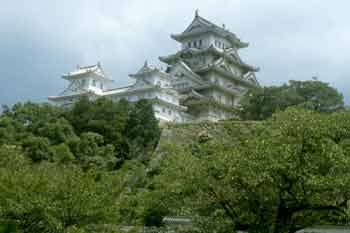 Most of the castles you see in Japan are modern (1950's) reconstructions. Himeji is one of the stops on the shinkansen line and is only about 1.5 hours from Kyoto or an hour from Osaka.
Most of the castles you see in Japan are modern (1950's) reconstructions. Himeji is one of the stops on the shinkansen line and is only about 1.5 hours from Kyoto or an hour from Osaka.
Construction first started in 1333 with the building of a fort at the site with premises been built in 1346. It was not until the middle of the 16thcentury that the original castle was built during the rule of Shigetaka Kuroda. The first of three moats was started in 1601 and the entire moat system was completed in 1609. Except for the outer moat which no longer exists and some outer bailey walls that were destroyed in the bombing raids of WWII, the castle has much the same as it was in 1618 when it was finished. It consists of a five story donjon and three smaller donjons and is surrounded by moats and defensive walls with openings to shot arrows and guns at attackers.
Sometimes there are English guides available, but it is hit and miss and you can't book in advance. To the west of the castle you will find Kōko-en, a reconstruction of the former samurai quarters based on archaeological work done in the early 90's. If you want to visit you can purchase a combination ticket to visit both the castle and Kōko-en. The site includes nine Edo-style gardens, two ponds, reconstructed buildings, and an expensive restaurant. There are cheaper restaurants near the castle.
There is also a history museum north of the castle but the castle is the only real site in Himeji, otherwise its a typical drab small city. The castle is worth the trip.
Osaka
|
Although 1400 years old Osaka was bombed flat during WWII and is now a typical modern Japanese city. Early in Japan's history, cultural exchange with China and Korea flowed through Osaka. The second largest city in the country it's a good place to experience modern Japanese urban life. The city is mainly a collection of concrete buildings and elevated highways but at night the abundance of neon lighting gives the city an almost surreal look. The Hollywood movie Black Rain was filmed here, although you might think Bladerunner could have been shot here. For modern attractions Osaka has some interesting attractions including Universal Studios where you can witness Japanese teens acting out the myth of Amerika. Osaka Aquarium has the world's largest tank which is the home of two whale sharks. The place is often packed with kids and expect long line-ups. The most interesting building is the Umeda Sky Building, a twin-tower building with a connecting top floor sky bridge or "Floating Garden" observation deck. You can't miss it from the train. |
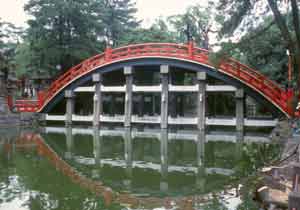
If you find modern cities can leave you kind of cold, Osaka does not have many traditional sites to visit, there is not even many museums. One of the few historical sites is Sumiyoshi-taisha which is Osaka's most important shrine and is dedicated to Shintō deities of the sea and sea travel. The shrine was founded in the early 3rdcentury and this shrine survived the bombing of WWII with some buildings dating to 1810, the other buildings are faithful reproductions.
Shitennō-ji is supposedly one of the oldest Buddhist temples in Japan, founded in 593, but the present buildings are concrete reproductions. The temple does have the oldest stone torii (entrance gate) in the country but this is about the only interesting historical thing there.
Osaka castle is the most popular attraction in the city. Its a modern concrete reconstruction of the 1583 castle. The original was destroyed in a civil war in the late 19thcentury. The bridge over the moat survived until 1944. The present building is a concrete reconstruction from 1931 and refurbished in 1997. For a more authentic castle visit Himeji just two hours away.
With about 3 million people you can experience the modern Japanese urban city without the 20+ million people of Tokyo, otherwise Osaka is the city you pass through to go to and from Kanasi International airport.
| Visit the Kyoto |
Visit Hiroshima |
Return to Travel Page |
Return to Main Page |